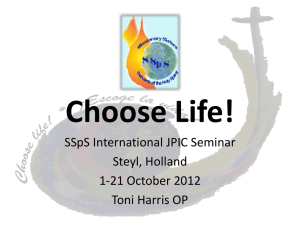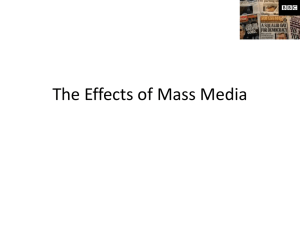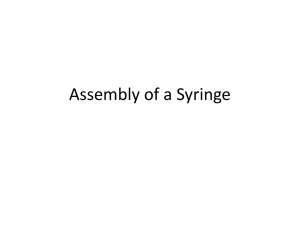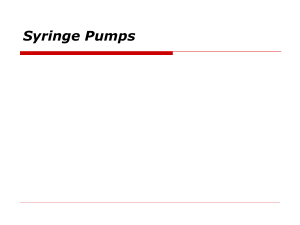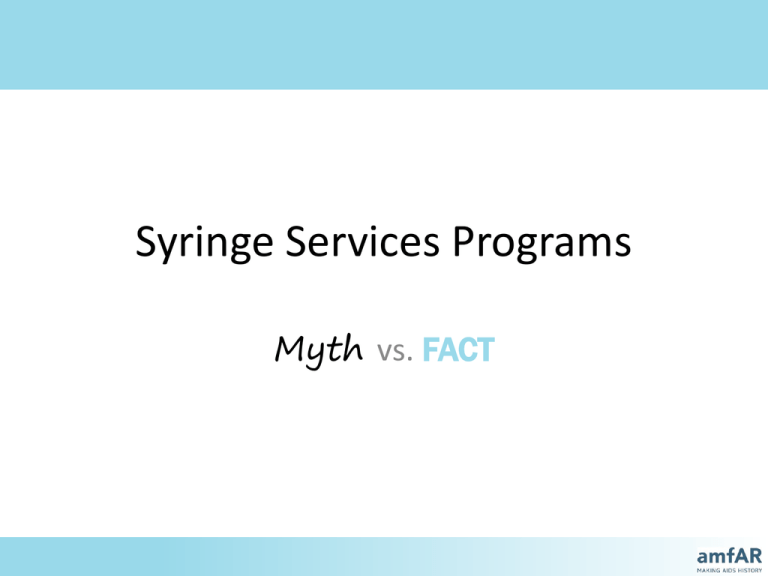
Syringe Services Programs
Myth vs. FACT
Ten Myths Surrounding
Syringe Services Programs (SSPs)
Myth 1: Syringe Services Programs
(SSPs) only give out needles.
Myth 6: SSPs do not enjoy broad
popular and professional support.
Myth 2: SSPs increase injection drug
use and undermine public safety.
Myth 7: Lifting the ban on federal
funding in 2009 did not make a
difference.
Myth 3: Supporting injection drug
users is not an efficient use of public
resources.
Myth 8: Lifting the current ban on
federal funding will not make a
difference.
Myth 4: Injection drug use is limited
and a problem of the past.
Myth 9: Support of SSPs is
unrealistic given the current fiscal
crisis.
Myth 5: HIV impacts all injection
drug users equally, regardless of race
or ethnicity.
Myth 10: Due to the success of
SSPs, our work is done.
Syringe Services Programs: Myth vs. Fact
Syringe Services Programs (SSPs) only
give out needles
SSPs provide a variety of syringe exchange
services throughout the country
o SSPs distribute free sterile syringes to
injection drug users (IDUs), which reduces
the likelihood that users will share
injecting equipment.1
o SSPs safely dispose of used needles, a
service not typically provided by
distributors such as pharmacies.
o SSPs make neighborhoods safer by
reducing needle-stick injuries.1
o SSPs operate in 166 cities in 30 states, the
District of Columbia, Puerto Rico, and
Indian Nations.2
1amfAR,
Federal Funding for Syringe Services Programs: Saving Money, Promoting Public Safety, and Improving Public Health. Available at:
http://www.amfar.org/uploadedFiles/_amfarorg/Articles/On_The_Hill/2013/issue-brief-federal-funding-for-syringe-service-programs.pdf.
2amfAR Syringe Exchange Program Coverage Map. Available from: Available at: http://www.amfar.org/uploadedFiles/_amfarorg/Articles/In_The_Community/2013/July%202013%20SEP%20Map%20.pdf
Syringe Services Programs: Myth vs. Fact
Available from: http://www.amfar.org/uploadedFiles/_amfarorg/Articles/In_The_Community/2013/July%202013%20SEP%20Map%20.pdf
Syringe Services Programs: Myth vs. Fact
Syringe Services Programs (SSPs) only
give out needles
SSPs provide a variety of syringe exchange
services throughout the country
o In Baltimore, SSPs helped reduce the number of improperly discarded syringes
by almost 50%. 1
o In Portland, Oregon, the implementation of SSPs reduced the number of
improperly discarded syringes by two-thirds.2
o In 2008 and 2009, Miami (which had no SSPs) saw eight times more improperly
disposed syringes than San Francisco (where SSPs are available) despite the fact
that San Francisco is thought to have twice as many IDUs.3
1Doherty,
M.C., Junge, B., Rathouz, P., Garfein, R.S., Riley, E., & Vlahov, D. (2000). The effect of a needle exchange program on numbers of discarded needles: A 2-year follow-up. American
Journal of Public Health, 90(6), 936-939.
2Oliver, K.J., Friedman, S.R., Maynard, H., Magnuson, L., & Des Jarlais, D.C. (1992). Impact of a needle exchange program on potentially infectious syringes in public places. Journal of Acquired
Immune Deficiency Syndromes, 5, 534–535.
3Tookes, H.E., et al. (2012). A comparison of syringe disposal practices among injection drug users in a city with versus a city without needle and syringe programs. Drug and Alcohol
Dependence, 123(1-3), 255-9.
Syringe Services Programs: Myth vs. Fact
Syringe Services Programs (SSPs) only
give out needles
SSPs provide a variety of services in addition
to syringe exchange1
o
o
o
o
o
o
Onsite medical care 1
Screening and counseling for HIV, hepatitis C, and
STIs (injection drug users are twice as likely as the
general public not to know their HIV status) 1,2
Distribution of safer sex supplies, food, and
clothing 1
Referrals to substance use treatment and support
groups 1
Medications and resources to prevent death from
drug overdose 3
Case management
1Des
Selected Services Offered by
SSPs Nationwide in 2010
Jarlais, D.C., Guardino, V., Nugent, A., Arasteh, K., & Purchase, D. (2012). (unpublished data) 2010 National Survey of Syringe Exchange Programs: Summary of Results. North American Syringe Exchange Network.
Available at: http://nasen.org/news/2012/jul/05/2010-beth-israel-survey-results-summary/.
2National Minority AIDS Council. Federal funding for syringe exchange. Available from: harmreduction.org/wp-content/uploads/2012/01/Syringe-Exchange-June-4-NMAC.pdf
3Des Jarlais, D.C., Guardino, V., Nugent, A., Arasteh, K., & Purchase, D. 2011 National Survey of Syringe Exchange Programs: Summary of Results. Presented at the 9 th National Harm Reduction Conference: “From Public
Health to Social Justice,” Portland, OR, November, 2012.
Syringe Services Programs: Myth vs. Fact
SSPs increase injection drug use and
undermine public safety
Statistics show that SSP services improve
public health and safety
o In New York City, the growth of SSPs from 1990 to 2001 was associated with a 78% decrease
in HIV prevalence among IDUs. 1
o During this time period, the same population saw a decrease in the prevalence of hepatitis C
from 90% to 63% 2
o One study showed that within 6 months of using federally-funded SSPs, clients saw a 45%
increase in employment. In addition, clients were 25% more likely to have been successfully
referred to mental health treatment and prescribed medication.3
o In New Jersey, 22% of the state’s SSP clients have entered drug treatment.4
1Des
Jarlais, DC, et al. (2005). HIV Incidence Among Injection Drug Users in New York City, 1990 to 2002: Use of Serologic Test Algorithm to Assess Expansion of HIV Prevention
Services. American Journal of Public Health 95.8: 1439-444.
2Des Jarlais, D.C., et al. (2005). Reductions in hepatitis C virus and HIV infections among injecting drug users in New York City, 1990-2001. AIDS, 19(suppl 3), S20-S25.
3Silverman, B., Thompson, D., Baxter, B., Jimenez, A.D., Hart, C., & Hartfield, C. (July 25, 2012). First federal support for community based syringe exchange programs: A panel presentation by
SAMHSA grantees (Poster--WEPE234). Presented at the International AIDS Conference Poster Session, Washington, D.C. Poster and abstract available online at
http://pag.aids2012.org/abstracts.aspx?aid=20133. (date last accessed: December 12, 2012).
4New Jersey Syringe Access Program Demonstration Project. (January 2010). Interim report: Implementation of P.L. 2006, c.99, “Blood-borne Disease Harm Reduction Act.” Available online at
http://www.state.nj.us/health/aids/documents/nj_sep_evaluation.pdf. (date last accessed: December 12, 2012).
Syringe Services Programs: Myth vs. Fact
SSPs increase injection drug use and
undermine public safety
SSPs connect IDUs with treatment and are
associated with reduced crime
o Neighborhoods in Baltimore with SSPs experienced an 11% decrease
in break-ins and burglaries, while areas without SSPs saw an 8%
increase in such crimes during the same period.1
o In Seattle, IDUs who had used SSPs were more likely to report a
significant decrease (>75%) in injection drug use, to stop using
injection drugs, and to remain in treatment than IDUs who had never
used SSPs.2
o The same study in Seattle found that new users of the SSP were five
times more likely to enter drug treatment than individuals who never
utilized the program.2
1Center
for Innovative Public Policies. Needle Exchange Programs: Is Baltimore a Bust? Tamarac, Fl.: CIPP; April 2001.
H. et al. (2000). Reduced injection frequency and increased entry and retention in drug treatment associated with needle-exchange participation in Seattle drug injectors. Journal of
Substance Abuse Treatment, 19, 247-252.
2Hagan,
Syringe Services Programs: Myth vs. Fact
SSPs increase injection drug use and
undermine public safety
SSPs promote public safety
o Needle stick injuries to law enforcement are a common
occurrence. In San Diego, nearly 30% of officers have
been stuck by a needle.1
o Decriminalization of syringes (and SSPs) has been tied to
reduced needle stick injuries. In South Carolina, where
syringes are legal, officers have experienced needle stick
injuries at half the rate of their counterparts in North
Carolina, where syringes are illegal.2
o In Connecticut, police officer needle stick injuries were
reduced by two-thirds after the establishment of SSPs.3
1Lorentz,
J., Hill, J., & Samini, B. (2000). Occupational needle stick injuries in a metropolitan police force. American Journal of Preventive Medicine, 18, 146–150.
NC Study Reveals that Law Enforcement Want to Reform Paraphernalia Laws. Available at http://www.nchrc.org/law-enforcement/north-carolina-law-enforcement-attitudes-towardssyringe-decriminalization/
3Groseclose, S.L., Weinstein, B., Jones, T.S., Valleroy, L.A., Fehrs, L.J., & Kassler, W.J. (1995). Impact of increased legal access to needles and syringes on practices of injecting-drug users and
police officers- Connecticut, 1992-1993. Journal of Acquired Immune Deficiency Syndromes & Human Retrovirology 10(1): 82-89.
2NCHRC.
Syringe Services Programs: Myth vs. Fact
SSPs increase injection drug use and
undermine public safety
SSPs promote public safety
Expert Observation:
“In the cities that have adopted needle services
programs, there is a dramatic reduction in needle sticks
to firefighters who crawl on their hands and knees
through smoke-filled rooms in search of victims.”
- Charles Aughenbaugh, Jr., President, New Jersey Deputy Fire
Chiefs Association, Retired Deputy Fire Chief, March 2011
Syringe Services Programs: Myth vs. Fact
Supporting injection drug users is not an
efficient use of public resources
We can save money by alleviating IDU
reliance on public sector resources1
o HIV-positive IDUs often rely on Medicaid, Medicare, or Ryan White
programs for their health care. This means that taxpayers will bear the
lion’s share of treatment costs associated with new infections related to
drug use.1
o The lifetime cost of treating an HIV-positive person is estimated to be
between $385,200 and $618,900.2
o With needles and syringes costing less than 50 cents each, it is far
cheaper to prevent a new case of HIV than to assume many years of
treatment costs.1
1amfAR,
Federal Funding for Syringe Services Programs: Saving Money, Promoting Public Safety, and Improving Public Health. Available at:
http://www.amfar.org/uploadedFiles/_amfarorg/Articles/On_The_Hill/2013/issue-brief-federal-funding-for-syringe-service-programs.pdf.
2Schackman, B.R., Gebo, K. A., & Walensky, R.P. et al. (2006). The lifetime cost of current Human Immunodeficiency Virus care in the United States. Medical Care, 44(11), 990-997.
Syringe Services Programs: Myth vs. Fact
Supporting injection drug users is not an
efficient use of public resources
SSPs are highly cost-effective
Every dollar invested in SSPs
results in
$3-7 in savings
just by preventing new HIV
infections.1
1Nguyen,
T. Q., Weir, B. W., Pinkerton, S. D., Des Jarlais, D.C., & Holtgrave, D. (2012). Increasing investment in syringe exchange is cost-saving HIV prevention: modeling hypothetical syringe
coverage levels in the United States (MOAE0204). Presented at the XIX International AIDS Conference, Washington, D.C. Session available online at
http://pag.aids2012.org/PAGMaterial/PPT/1064_1420/tnsepcostsavingiac2012.pptx.
Syringe Services Programs: Myth vs. Fact
Supporting injection drug users is not an
efficient use of public resources
SSPs are highly cost-effective
Positive impact of funding SSPs1
A recent study has shown
that an investment of $64
million would result in an
estimated
$193 million in savings
by preventing 500 new HIV
infections.1
1Nguyen,
T. Q., Weir, B. W., Pinkerton, S. D., Des Jarlais, D.C., & Holtgrave, D.
(2012). Increasing investment in syringe exchange is cost-saving HIV prevention:
modeling hypothetical syringe coverage levels in the United States (MOAE0204).
Presented at the XIX International AIDS Conference, Washington, D.C. Session
available online at http://pag.aids2012.org/Abstracts.aspx?SID=198&AID=17268.
Syringe Services Programs: Myth vs. Fact
SSP syringe coverage
Supporting injection drug users is not an
efficient use of public resources
SSPs are highly cost-effective
o Between 2001 and 2011, Illinois saw a drop of nearly twothirds in new HIV cases among IDUs, averting an estimated
$200 million in medical expenses.1
o In Massachusetts, there was a 54% decrease in new HIV
diagnosis between 1999 and 2012, preventing 5,699 infections
and saving more than $2 billion in health care costs.2
o King County (Washington State) spent $1.1 million on SSPs in
2008. If HIV was prevented among only 1% of IDUs in King
County, the resulting savings in HIV treatment costs will be $70
million.3
1AIDS
Foundation of Chicago. AFC Statement on Federal Funding Ban for Syringe Exchanges. Retrieved from: http://www.aidschicago.org/national-news/416-afc-statement-on-federal-fundingban-for-syringe-exchanges.
2AIDS Action Committee. President Obama’s Fiscal 2013 Budget Demonstrates Commitment To Ending HIV/AIDS Epidemic In America. Available at:
http://www.aac.org/media/releases/president-obamas-fiscal-2013.html.
3Public Health – Seattle & King County Needle Exchange Program. Available at: http://www.kingcounty.gov/healthservices/health/communicable/hiv/resources/aboutnx.aspx.
Syringe Services Programs: Myth vs. Fact
Injection drug use is limited and a
problem of the past
Injection drug use is expanding among nontraditional drugs such as prescription drugs1
o
Individuals using prescription drugs nonmedically may turn to injection as a more efficient method of drug
delivery.1 Additionally, the high cost of prescription drugs and crackdown on prescription drug use can cause
IDUs to transition to heroin use.2
o
A recent report by the Substance Abuse and Mental Health Services Administration (SAMHSA) showed that
those who reported prior use of nonmedical pain relievers were 19 times more likely to have recently begun
using heroin than those who had not used nonmedical pain relievers. The report also showed that 79.5% of
people who recently began using heroin had previously used prescription drugs for nonmedical purposes. 3
o
Heroin use has increased dramatically nationwide in the past several years. Whereas in 2007, SAMHSA
reported there to be 373,000 recent heroin users in the US, this number jumped to 669,000 in 2012.4
o
SSPs play an important role in addressing the needs of new IDUs. Other outlets for these individuals to feel
safe accessing care and treatment are scarce.
1Havens,
J., Walker, R., Leukefeld, C. (2007). Prevalence of opioid analgesic injection among rural nonmedical opioid analgesic users. Drug and Alcohol Dependence 87, 98-102. Available at:
http://www.ncbi.nlm.nih.gov/pubmed/16959437.
2Elinson, Z., & Campo-Flores, A. (2013). Heroin Makes a Comeback. The Wall Street Journal. http://online.wsj.com/article/SB10001424127887323997004578640531575133750.html.
3Muhuri, P.K., Gfroerer, J.C., & Davis, M.C. (2013). Associations of Nonmedical Pain Reliever Use and Initiation of Heroin Use in the United States. SAMHSA, CBHSQ Data Review.
http://www.samhsa.gov/data/2k13/DataReview/DR006/nonmedical-pain-reliever-use-2013.pdf
4Substance Abuse and Mental Health Services Administration, Results from the 2012 National Survey on Drug Use and Health: Summary of National Findings, NSDUH Series H-46, HHS Publication No. (SMA) 13-4795.
Rockville, MD: Substance Abuse and Mental Health Services Administration, 2013.
Syringe Services Programs: Myth vs. Fact
Injection drug use is limited and a
problem of the past
Injection drug use is expanding among nontraditional drugs such as prescription drugs1
Injection drug use among prescription drug abusers in Kentucky: A Case Study
o A recent study has found that 35.3% of nonmedical prescription opioid users in
rural Kentucky are now injecting the drug.1
o This value is higher than was previously reported among that population,
demonstrating an increase in injection as the method for nonmedical
prescription opioid users to administer their drugs.1
o Due to this rise in injection drug use, there is a need for syringe exchange and
related education and treatment services for this population to prevent the
spread of HIV and hepatitis C.1
1Havens,
J., Walker, R., Leukefeld, C. (2007). Prevalence of opioid analgesic injection among rural nonmedical opioid analgesic users. Drug and Alcohol Dependence 87, 98-102. Available at:
http://www.ncbi.nlm.nih.gov/pubmed/16959437.
Syringe Services Programs: Myth vs. Fact
HIV impacts all injection drug users equally,
regardless of race or ethnicity
The prevalence of HIV among Hispanic and African-American
IDUs is nearly twice as high as it is for Caucasians1
Source: CDC. (2012).
HIV surveillance in
injection drug users
(through 2010).
Available online at:
http://www.cdc.gov/hi
v/idu/resources/slides
1CDC. (2009). HIV
infection and HIVAssociated Behaviors
Among Injecting Drug
Users. Morbidity and
Mortality Weekly
Report, 61(08): 133138. Available from:
http://www.cdc.gov/m
mwr/preview/mmwrht
ml/mm6108a1.htm
Syringe Services Programs: Myth vs. Fact
HIV impacts all injection drug users equally,
regardless of race or ethnicity
The prevalence of HIV among Hispanic and African-American
IDUs is nearly twice as high as it is for Caucasians1
Expert Observation:
“As the Chairman of the National Black
Leadership Commission on AIDS Inc., and the
resident of a state with a sizeable Latino
community, I have personally witnessed these
disproportionate and devastating results.”
- Reverend Dr. W. James Favorite, Senior Pastor of
Beulah Baptist Institutional Church and Chair of the
Black Leadership Commission on AIDS of Tampa Bay
1CDC. (2009).
HIV infection and HIV-Associated Behaviors Among Injecting Drug Users. Morbidity and Mortality Weekly Report, 61(08): 133-138. Available from:
http://www.cdc.gov/mmwr/preview/mmwrhtml/mm6108a1.htm
Syringe Services Programs: Myth vs. Fact
HIV impacts all injection drug users equally,
regardless of race or ethnicity
SSPs help reduce health disparities among
IDUs by increasing access to health services
SSPs represent a critical
tool for minimizing HIV
risks and addressing health
disparities by reaching the
IDU community with vital
syringe and health
services.1
1amfAR,
Federal Funding for Syringe Services Programs: Saving Money, Promoting
Public Safety, and Improving Public Health. Available at:
http://www.amfar.org/uploadedFiles/_amfarorg/Articles/On_The_Hill/2013/issue
-brief-federal-funding-for-syringe-service-programs.pdf
2Available at: http://news.medill.northwestern.edu/chicago/news.aspx?id=86315
Syringe Services Programs: Myth vs. Fact
Source: Medline Reports Chicago2
SSPs do not enjoy broad popular and
professional support
State, local, and faith-based organizations
around the country already support SSPs
SSPs also enjoy support from faith
communities, including:
The following organizations support SSPs:
o
o
o
o
o
o
o
o
o
o
o
o
o
o
o
o
o
American Academy of Family Physicians
American Academy of Pediatrics
American Bar Association
American Medical Association
American Public Health Association
American Society of Addiction Medicine
International Red Cross-Red Crescent Society
Latino Commission on AIDS
NAACP
National Academy of Sciences
National Black Police Association
National Institute on Drug Abuse
Office of National Drug Control Policy
Presidential Advisory Committee on AIDS
US Conference of Mayors
World Bank
World Health Organization
Syringe Services Programs: Myth vs. Fact
•
Central Conference of American Rabbis
•
Episcopal Church
•
National Council on Jewish Women
•
Presbyterian Church of the United States
•
Society of Christian Ethics
•
Union for Reform Judaism
•
Unitarian Universalist Association
•
United Church of Christ
SSPs do not enjoy broad popular and
professional support
State, local, and faith-based organizations
around the country already support SSPs
Expert Observation:
"Syringe decriminalization and exchange is ...an issue of compassion and
justice... As people of faith, we are called to be the embodiment of that
compassion and instruments of that justice in this world to offer an eternal
hope. The hope that someone may live another day. The hope that they may
be reconciled with their family. The hope that they can live a life free of
disease. The hope that they might choose to find treatment. The hope that
with that one more day, they might find their own hope for a future outside of
their addiction."
- Pastor James Sizemore, Lead Pastor, Catalyst Community Church, Fayetteville, North Carolina
Syringe Services Programs: Myth vs. Fact
Lifting the ban on federal funding in 2009
did not make a difference
Lifting the ban on federal funding, even for a short
time, positively affected SSPs around the country
o In 2009, Congress removed a 21-year prohibition on the use of federal
funds to support SSPs.1 Two years later, Congress re-imposed the ban on
federal funding for SSPs.2
o While the ban was lifted, federal dollars were used to support SSPs in
California, Connecticut, Delaware, Illinois, Massachusetts, Minnesota,
New Jersey, New Mexico, New York, Puerto Rico, Vermont, and
Washington.3
o These dollars were used to: expand service hours, provide services in new
locations, and provide additional services such as case management and
overdose prevention services.
1Consolidated
Appropriations Act, 2010. Public law 111-117. (December 16, 2009. Sections 505 and 810.) Available at: http://www.gpo.gov/fdsys/pkg/PLAW-111publ117/pdf/PLAW111publ117.pdf.
2Consolidated Appropriations Act, 2012. Public law 112-74. (December 23, 2011. Section 523.) Available at: http://www.gpo.gov/fdsys/pkg/PLAW-112publ74/pdf/PLAW-112publ74.pdf.
3 Personal communication, state agency officials.
Syringe Services Programs: Myth vs. Fact
Lifting the ban on federal funding in 2009
did not make a difference
Lifting the ban on federal funding, even for a short
time, positively affected SSPs around the country
Expert Observation:
"The reinstatement of the ban had several immediate effects. The State of New Jersey stopped any
support for [SSPs] in December 2011 because most of the state prevention funding is federal
dollars…The second effect has been an increased reluctance on the part of foundations and other
funders to support our [SSPs]. The ban is sometimes perceived as a judgment of the effectiveness of
[SSPs] rather than the political maneuver that it really is. In New Jersey, we fought for over 20 years to
get the legislation passed to set these programs up and after almost 5 years of overwhelming success
the programs are all in danger of closing because of lack of funds."
- Bob Baxter, Director of Addiction and Educational Services, NJCRI
“Since our local health department does not fund the personnel costs associated with our harm
reduction work on the southeast side of Chicago, the biggest impact of the impending reinstatement of
the federal ban will likely be felt by IDUs at risk for HIV/HCV and drug overdose in this region."
- Antonio Jimenez, Project Director, SSP Initiative, UIC
Syringe Services Programs: Myth vs. Fact
Lifting the current ban on federal funding
will not make a difference
Lifting the ban on federal funding is
important to maintain SSPs
o Federal dollars open doors. Federal funding is often perceived by
other donors as a "seal of approval,” leading to new funding
streams. Federal grantees can also receive extensive technical
assistance at no cost.1
o State and local budgets are dwindling. This means that federal
dollars are important in maintaining and expanding existing
services.
o It's about local control. State and local decision makers should
have flexibility in the use of federal funds to address local health
concerns.
1Bob
Baxter, Director of Addiction and Educational Services, NJCRI
Syringe Services Programs: Myth vs. Fact
Lifting the current ban on federal funding
will not make a difference
Lifting the ban on federal funding is
important to maintain SSPs
Expert Observation:
“By restoring the ban on federal funding
for syringe exchange, members of
Congress undoubtedly believed they were
striking a blow against drug use. As
extensive experience has shown, nothing
could be further from the truth. By
withholding funding for syringe
exchange, Congress has made our
communities less safe, made police
officers and medical responders unsafe,
undermined a vital bridge to drug
treatment, and hindered national efforts
to address public health problems such as
HIV and hepatitis C.”
- Chief James Pugel, Seattle Police Department
Syringe Services Programs: Myth vs. Fact
Lifting the current ban on federal funding
will not make a difference
Lifting the ban on federal funding is
important to maintain SSPs
Expert Observation:
“Ending the ban on the use of federal funds for syringe services programs remains an
urgent priority for the public health, HIV/AIDS, viral hepatitis, and harm reduction
communities. Sustaining and expanding access to sterile syringes and comprehensive
services for people who inject drugs is of vital importance to disease control efforts, as
state and local jurisdictions struggle to adequately resource these programs as they
confront new challenges and growing demand. We are extremely concerned that the
FY 2012 federal funding ban may worsen access to HIV testing and prevention
interventions for this key risk group, exacerbate HIV-related racial and ethnic health
disparities among injection drug users, and jeopardize our ability to meet the goals
of the [National HIV/AIDS Strategy].”
- PACHA Syringe Exchange Letter to President Obama, May 17, 20121
1Presidential
Advisory Council on HIV/AIDS. (2012). Syringe Exchange Letter to President Obama. Available at: http://aids.gov/federal-resources/pacha/meetings/2012/may-2012-letter-topresident.pdf.
Syringe Services Programs: Myth vs. Fact
Support of SSPs is unrealistic given the
current fiscal crisis
Lifting the ban on federal funding of SSPs
saves money and lives without costing a dime
o The cost of lifting the ban on federal funding is nothing.
o It simply allows localities to spend their federal prevention
dollars as they see fit.
o SSPs are highly cost-effective, saving an average of $3-7 for
every $1 spent. Supporting cost-effective programs is especially
important during fiscal crises.1
1Nguyen,
T. Q., Weir, B. W., Pinkerton, S. D., Des Jarlais, D.C., & Holtgrave, D. (2012). Increasing investment in syringe exchange is cost-saving HIV prevention: modeling hypothetical syringe
coverage levels in the United States (MOAE0204). Presented at the XIX International AIDS Conference, Washington, D.C. Session available online at
http://pag.aids2012.org/PAGMaterial/PPT/1064_1420/tnsepcostsavingiac2012.pptx..
Syringe Services Programs: Myth vs. Fact
Due to the success of SSPs, our work is done
Our work is far from over
o SSPs do not reach all IDUs. As a result,
injection drug use still causes 14% of new
HIV infections among women and 7-11%
of new infections among men.1
o There are 3.2 million Americans living
with hepatitis C, the leading cause of
liver transplant in the US.2,3
o More Americans ages 25 to 64 lose their
lives to drug overdose than motorvehicle crashes.4
Syringe Services Programs: Myth vs. Fact
1CDC.
(2012). HIV Surveillance in Injection Drug Users (through 2010). Available at:
http://www.cdc.gov/hiv/idu/resources/slides/slides/HIV_injection_drug_users.pdf.
2CDC. (2012). Hepatitis C for Health Professionals: Overview and Statistics. Available at:
http://www.cdc.gov/hepatitis/HCV/HCVfaq.htm.
3National Digestive Diseases Information Clearinghouse. (2012). Liver Transplantation.
Available at: http://digestive.niddk.nih.gov/ddiseases/pubs/livertransplant/
4CDC. (2013). Drug Overdose in the United States: Fact Sheet. Available at:
http://www.cdc.gov/homeandrecreationalsafety/overdose/facts.html
Due to the success of SSPs, our work is done
YOU can help
o Learn more: visit amfar.org/endtheban
and theexchange.amfar.org. Watch the
ten-minute movie, “The Exchange,” as
well as the shorts, “Dollars & Sense,”
“Race & Drugs,” and “Addiction & You.”
o Sign the petition:
https://www.surveymonkey.com/s/EndTheBan
o Get the word out: host a film
screening, post the links on facebook,
send a tweet, and share on listservs.
Syringe Services Programs: Myth vs. Fact
Due to the success of SSPs, our work is done
YOU can help
o Call your representative in Congress as
o
o
o
Students with Senator Blumenthal (CT).
Syringe Services Programs: Myth vs. Fact
o
an individual or as a group event.
Write an op-ed, blog post, or letter to
your representative in Congress.
Visit your congressional office, either
in-state or in DC.
Work with your local SSP:
volunteer, donate, ask them to speak
to your group (go to www.nasen.org to
find the SSP nearest you). Ask your
representative in Congress to visit the
local SSP and see it for themselves.
Not sure how? Go to
www.amfar.org/endtheban.
SSPs FACTS Summary
o SSPs save lives by preventing the spread of HIV and by serving as a
bridge to other services, including drug treatment.
o SSPs are good for everyone: IDUs, first-responders, law enforcement,
and general public safety.
o In light of prescription drug misuse and its expansion into injection drugs,
the need for SSPs is greater than ever.
o SSPs can reduce health disparities between racial and ethnic groups
by increasing access to health care.
o SSPs enjoy broad support from medical, legal, public health, faith, and
local communities.
o It’s a matter of local control. State and local decision makers should have
flexibility in the use of federal funds to address local health concerns.
o Lifting the ban costs nothing and saves money.
Syringe Services Programs: Myth vs. Fact

